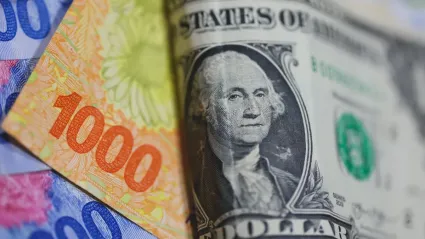The North American currency ends February with strong nominal declines in the informal sector and equity markets. Why is this? The decline of the dollarWhat are the consequences of the event and what can be expected in the future.
The blue dollar is sold in the city of Buenos Aires Its nominal minimum since early 2024. The entire month of February accumulated a decline of $165 The gap with the official gross exchange rate fell below 23%. so, It is clearly losing the race against inflation by 2024.
Financial dollars are also at their lowest level since the beginning of the year. In February, the MEP dollar accumulated a decline of $144Bringing the gap with the official gross exchange rate to 22.5% The CCL dollar accumulated a monthly drop of $178and interval The official gross exchange rate is 27.5%.
Why is the dollar falling?
The reason for the fall in dollar prices can be summed up by saying that pesos are low and dollars are low today.. The interaction of the forces of supply and demand in the money market is behind this, and a recent post by the nation's president, Javier Millay, on the social network X points to this.
The Dollar and Inflation
Inflation is always and everywhere a monetary phenomenon that arises from an oversupply of money, which causes the purchasing power of the currency to fall and all prices expressed in units of the local currency to rise. The dollar is an asset…— Javier Milei (@JMilei) February 29, 2024
The decline in the CCL dollar was associated with an increase in the supply of dollars, as the devaluation of the official exchange rate increased exports in value and volume.. It should be noted that under the current regime, exporters pay 20% of foreign exchange sold abroad into this market. More exports mean more supply of dollars in the stock market, which lowers prices.
The decline of the MEP dollar and the blue dollar is explained by the high demand for pesos, resulting in an oversupply of dollars.. As more pesos are absorbed by poplar tenders (a bonus for free Argentina's reconstruction), many importing companies are forced to disarm their positions in dollars to face liabilities in pesos, especially as recession affects their liquidity. Inflation in cost structure.
Likewise, the loss of purchasing power forces many households to sell their saved dollars. Faced with the need to pay off debts or pay current expenses in pesos, this contributes to exchange rate appreciation.
A loss of purchasing power forces households to sell dollars they have saved due to the need to pay debts in pesos or pay current expenses.
Alto AbramEconomist of the Libertad y Progreso Foundation, shared with RÍO NEGRO DIARY Your diagnosis. “Currently, The purchasing power of pesos is 40% to 50% of what it was when Miley took office., so people see a few pesos in their pockets today,” he said. “You bought dollars for not having pesos, but suddenly you need more pesos. what are you doing You sell dollars” he added.
Likewise, he said, quick recovery of fiscal surplus and adjustment of public accounts are well received in the market. “The government promised to fix the public accounts, and it fixed them, so you see there is a belief, things are being done, and This tended to give more assurance to people and investors who started leaving less capital, which is what we are seeing now.“, he pointed out.
The only exchange rates that have not shown a nominal fall recently are the official ones because they are controlled by the government and established on the basis of a gradual devaluation regime (crawling peg). However, pressures were also strongly relaxed in that segment: Purchases of savings dollars fell 86% year over year in January. A reversal of this trend cannot be expected in February, with a fall in parallel prices.
Consequences
The collapse of parallel quotes, simultaneously with the peg regime creeping into the official market, results in a narrowing of the exchange gap. Its most important effect is that it dampens expectations of peso devaluation.
This is particularly relevant given President Millay's promise to remove exchange controls and move towards an exchange rate unification soon. A smaller gap paves the way toward that goal, and reduces the necessary increase in the official exchange rate to stabilize..
That is another consequence of the silence in the parallel exchange markets Moderates inflation expectations and initial price tags, very common in recent times. Javier Miele, there is no causality between the price of the dollar and the price of goods and services, but the updates of the latter have a higher lag. The translation is that the President believes that the current exchange rate hike is an improvement on the fall in inflation.
The calm in the parallel exchange markets moderates inflationary expectations.
“To the extent that you don't create a new loss in purchasing power, Prices have nothing to reflect forward and the trend for inflation must be downwardsAbram said.
finally, A decline in the CCL dollar means exporters are getting fewer pesos for their sales abroad. A continuation of the crawling peg of 2% month-on-month, an increase in costs and a decrease in the price of the CCL dollar may compromise the competitiveness of Argentine products in foreign markets.
This content was Originally published In RÍO NEGRO and republished as part of the “Human Journalism” project, the Alliance for Quality Journalism between Black River and network/action.

